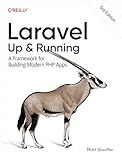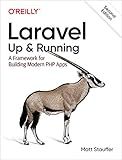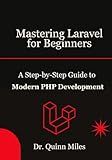Best Laravel Programming Guides to Buy in January 2026

Laravel: Up & Running: A Framework for Building Modern PHP Apps



Laravel 12 for Beginners & Beyond: A Complete Guide to Building Modern PHP Web Applications with Clean Architecture, Hands-On Projects, and Best Practices



Laravel: Up & Running: A Framework for Building Modern PHP Apps



Mastering Laravel for Beginners: A Step-by-Step Guide to Modern PHP Development



Architecture of complex web applications. Second Edition.: With examples in Laravel(PHP)



Ultimate Laravel for Modern Web Development: Build Robust and Interactive Enterprise-Grade Web Apps using Laravel's MVC, Authentication, APIs, and ... (Advanced Web Frameworks — Multi-Tech Path)


To use left join and group by in Laravel, you can first define the relationships between your model classes using Eloquent ORM. Then, you can use the leftJoin() method to perform a left join between two tables in your database. After that, you can use the groupBy() method to group the results based on a specific column. Finally, you can fetch the results using the get() method. This allows you to retrieve data from multiple tables and group the results based on certain criteria, providing you with the flexibility to manipulate and display the data as needed.
What is the recommended approach for using left join and group by in Laravel?
The recommended approach for using left join and group by in Laravel is to first define the relationships between the models using Eloquent and then use the query builder to perform the left join and group by operations.
Here is an example of how to use left join and group by in Laravel:
// Define the relationships in the models class User extends Model { public function posts() { return $this->hasMany(Post::class); } }
class Post extends Model { public function user() { return $this->belongsTo(User::class); } }
// Perform the left join and group by operation in the controller $users = User::leftJoin('posts', 'users.id', '=', 'posts.user_id') ->select('users.id', 'users.name', DB::raw('COUNT(posts.id) as post_count')) ->groupBy('users.id') ->get();
In this example, we first define the relationships between the User and Post models. Then, in the controller, we use the query builder to perform a left join between the users and posts tables on the user_id column. We select the user id and name from the users table and count the number of posts for each user using the COUNT function. Finally, we group the results by the user id.
This approach allows us to easily perform left join and group by operations in Laravel while leveraging the power of Eloquent relationships.
How to troubleshoot errors when using left join and group by in Laravel?
When encountering errors while using left join and group by in Laravel, there are several steps you can take to troubleshoot and resolve the issue:
- Check your SQL query: Verify that your SQL query is correctly structured and all necessary columns are selected in the select statement. Double-check the syntax of your left join and group by clauses.
- Verify your model relationships: Make sure that the relationships between the models are properly defined in your Eloquent models. Ensure that the foreign key and the column used for grouping are correctly specified in the relationships.
- Use eager loading: If you are using Eloquent relationships to perform the left join, consider using eager loading to load the related models in a single query. This can help improve performance and avoid potential issues with the query.
- Debug the query: Use Laravel's query logging feature to debug the generated SQL query. You can enable query logging by setting the 'DB::enableQueryLog()' method before executing the query and then retrieve the logged queries using 'DB::getQueryLog()'.
- Check for any errors in the data: Verify that the data in the tables you are querying is correct and does not contain any inconsistencies or missing data. Errors in the data can lead to unexpected results when using left join and group by clauses.
- Test with a simpler query: If you are still facing issues, try simplifying your query by removing unnecessary conditions or clauses. This can help isolate the problem and identify the specific cause of the error.
By following these steps, you can troubleshoot errors when using left join and group by in Laravel and identify the root cause of the issue to resolve it effectively.
How to handle large datasets when using left join and group by in Laravel?
When dealing with large datasets in Laravel and using left join and group by clauses, it is important to optimize your queries to improve performance. Here are a few tips on how to handle large datasets in this scenario:
- Use indexes: Make sure that your database tables have indexes on the columns that are being used in the join and group by clauses. Indexes can significantly improve query performance, especially when dealing with large datasets.
- Limit the number of rows returned: If you are dealing with a large dataset, it is a good practice to limit the number of rows returned in your query. You can use the take method or pagination to limit the number of rows fetched from the database.
- Use eager loading: If you are fetching related data using the left join clause, consider using eager loading to minimize the number of queries executed. Eager loading retrieves all related data in a single query, reducing the overall database overhead.
- Use database optimizations: Consider optimizing your database schema and queries to improve performance. This could include denormalizing the data, using proper database indexes, and writing efficient SQL queries.
- Use caching: If your dataset is static or changes infrequently, consider caching the results of your query to improve performance. Laravel provides built-in caching mechanisms that can be used to store and retrieve query results.
By following these tips and best practices, you can effectively handle large datasets when using left join and group by in Laravel and improve the performance of your application.
What is the error handling mechanism for left join and group by in Laravel?
In Laravel, when using a left join and group by, the error handling mechanism primarily involves checking if the result of the query is empty or not. This can be done using the isEmpty() method on the query result.
For example:
$users = DB::table('users') ->leftJoin('posts', 'users.id', '=', 'posts.user_id') ->groupBy('users.id') ->get();
if($users->isEmpty()) { // Handle error here echo "No users found"; } else { // Process the result here foreach($users as $user) { echo $user->name; } }
By using the isEmpty() method, you can easily check if the query returned any results or not and handle the error accordingly. Additionally, Laravel provides other error handling mechanisms such as exception handling and logging to help in debugging and resolving any issues that may arise during query execution.
What is the role of indexes in optimizing left join and group by queries in Laravel?
Indexes play a crucial role in optimizing left join and group by queries in Laravel. By creating indexes on the columns that are frequently used in join and group by operations, database engines can quickly locate the relevant data without having to scan the entire table.
When performing a left join operation, indexes help in efficiently matching the rows from the two tables based on the join condition. This can significantly reduce the time taken to retrieve the desired results.
In the case of group by queries, indexes help in sorting and grouping the data based on the specified columns. By having indexes on the group by columns, the database engine can quickly group the data together and calculate the aggregations, resulting in faster query execution.
Overall, using indexes in left join and group by queries can greatly improve the performance of the queries and reduce the overall execution time.
What is the default behavior of left join and group by in Laravel?
In Laravel, when using a left join and group by, the default behavior is to return a collection of all records from the left table, even if there are no matching records in the right table. The group by clause aggregates the results based on the specified column(s) and combines them into a single row for each group of values.
